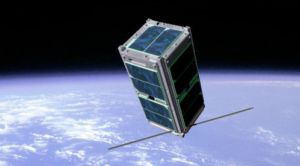
Kenya’s first indigenously-built satellite was launched by a SpaceX Falcon-9 space launch vehicle to the International Space Station (ISS) on 2 April 2018 from Cape Canaveral, Florida.
The satellite, called First Kenya University Nano Satellite-Precursor Flight (1KUNS-PF) was built by a team from the University of Nairobi, with technical assistance from staff from the University of Rome, and co-funded by the Japanese Aerospace Exploration Agency (JAXA) and the United Nations Office for Outer Space Affairs (UNOOSA) as part of the KiboCUBE programme.
1KUNS-PF will be launched from the Japanese Kibo module of the ISS in May 2018, and once in orbit will be used for monitoring agricultural activities in Kenya.
“Kenya is very proud to be associated and involved through TICAD VI in the development of the Satellite. We hope this is only a beginning of many collaborations and initiatives for Kenya under the KiboCUBE programme,” said Cabinet Secretary (CS) for Foreign Affairs Monica Juma.
“This is a milestone in Kenya’s exploration into space,” CS Juma added.
Yet despite the launch of 1KUNS-PF last week, Kenya’s space activities and ambitions are still without any policy direction and strategic guidance.
After being announced with much fanfare by Kenya’s President Uhuru Kenyatta in March 2017, the Kenyan Space Agency seems to be stuck in political limbo, with no executive board and agency head appointed by Kenya’s CS for Defence, Raychelle Omamo.
“Last year was a very busy year for the country. Most of the year was spent on electioneering. So, we were waiting for the political dust to settle down,” Dr. John Kimani, lead scientist at the Kenyan Space Agency, which operates under the authority of Kenya’s defence ministry, told Kenya’s Daily Nation newspaper in an interview in February 2018.
“After that, the Defence CS [Cabinet Secretary] will also appoint three independent members of the board, in consultation with the Executive,” Dr. Kimani added.
“Once we have that in place, then we will be ready to constitute and inaugurate the board. I can see that happening before June this year,” Kimani said.
The 1KUNS-PF nanosatellite seems to have beaten Kenyan politicians to the punch, however, a development that is at odds with the practice of most other emerging spacepowers where space legislation, policies, and an administrative and policy-making body such as a space agency are already in place before satellites are launched.
“Using space technology, we will be able to advise farmers about their soils: what needs to be added to their soils,” Dr. Kimani said regarding the 1KUNS-PF nanosatellite.
“Instead of doing the manual soil analysis, using space you can tell the type of soils that we have, what needs to be added, what can best grow in such soil,” Kimani said regarding the benefit of satellites for Kenyan agriculture.
Recently, the Kenyan politician ultimately responsible for formally establishing the Kenyan Space Agency told an international space conference hosted in Nairobi about the benefits of space programmes for African countries such as Kenya.
“Space technologies can provide effective solutions to the many problems of food security, provision of water and healthcare as well as job creation that African countries need.” Defence Cabinet Secretary Raychelle Omamo said.
For many years now a number of Kenyan space experts and politicians have lobbied for the creation of a national space agency and a national space programme.
Kenya is a “sleeping giant” when it comes to space, according to Professor Paul Baki, a professor at the Technical University of Kenya (TUK).
“We have not made use of our geographic location on the Equator; because this is the best place to launch satellites into space. You need minimum energy to send it there. If you’re off the equator, you must spend tonnes of fuel to put something into orbit,” he said, referring to the Malindi spaceport on the Kenyan coast located near to the Equator.
“This is an area where the government needs to find a partner to work with. Launch of satellites is big business and that alone can help us rake in billions of shillings,” Baki
At present the Malindi spaceport is leased by the Italian Space Agency, who call it the Broglio Space Centre, but a space launch has not occurred there for several decades, a source of some frustration among many in Kenyan space circles.
That frustration is likely to continue so long as the Kenyan government does not move to formally establish its national space agency.
“We tabled the Kenya Space Policy documents to the Cabinet for approval. We realised that if we went the route of the Bill in Parliament it would have taken longer. So, we converted the Bill into an executive order,” said Kimani.
“Already, there are many interest groups wanting to do things with us as Kenyans. But without a properly functional agency, there is very little room for engagement,” said Baki.





